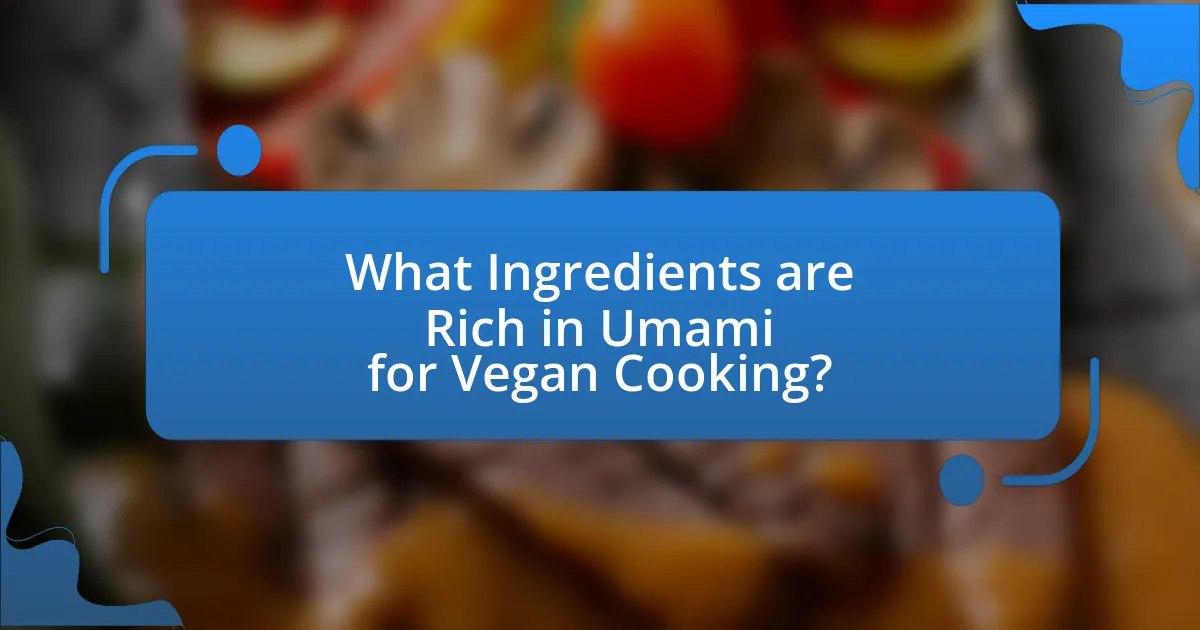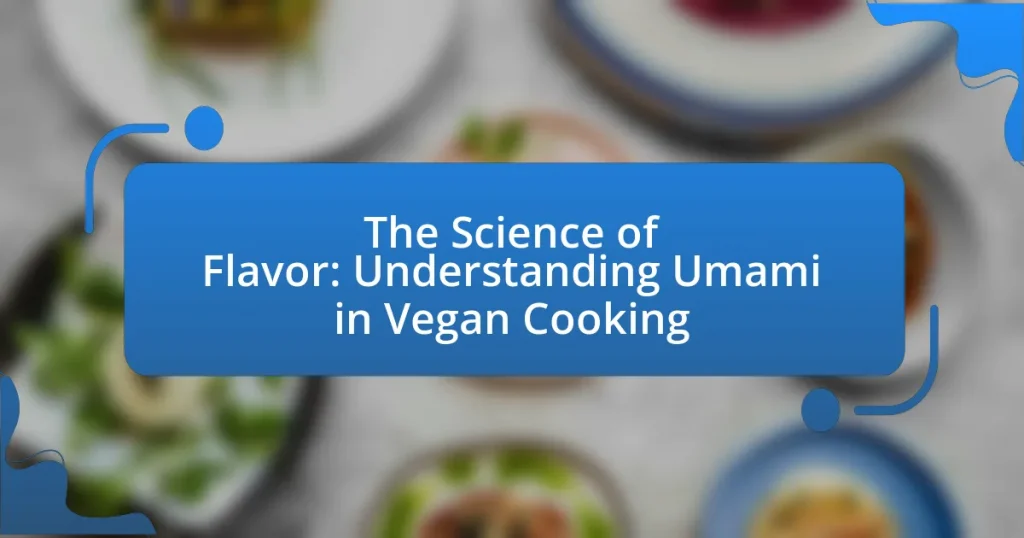Umami, recognized as the fifth basic taste, plays a vital role in vegan cooking by enhancing the depth and complexity of flavors in plant-based dishes. This article explores the characteristics of umami, its significance in flavor perception, and how it can be effectively incorporated into vegan recipes using ingredients such as mushrooms, tomatoes, and fermented products. Additionally, it discusses techniques for maximizing umami flavor, common mistakes to avoid, and practical tips for creating satisfying and flavorful vegan meals. Understanding umami is essential for vegan cooks aiming to elevate their culinary creations and provide a more enjoyable dining experience.

What is Umami and Why is it Important in Vegan Cooking?
Umami is one of the five basic tastes, characterized by a savory flavor often associated with foods rich in glutamate, such as mushrooms, tomatoes, and fermented products. In vegan cooking, umami is crucial because it enhances the depth and complexity of flavors, compensating for the absence of meat and dairy, which are typically rich in this taste. Research indicates that incorporating umami-rich ingredients can significantly improve the palatability of plant-based dishes, making them more satisfying and enjoyable for consumers.
How is Umami Defined in the Context of Flavor?
Umami is defined as the fifth basic taste, characterized by a savory flavor profile often associated with amino acids, particularly glutamate. This taste enhances the overall flavor experience in foods, making them more palatable and satisfying. Research indicates that umami is detected through specific receptors on the tongue that respond to glutamate and other related compounds, such as inosinate and guanylate, which are commonly found in foods like mushrooms, tomatoes, and fermented products. This scientific understanding of umami’s role in flavor is crucial for enhancing vegan cooking, as it allows for the incorporation of ingredients that provide depth and richness without animal products.
What are the key characteristics of Umami flavor?
Umami flavor is characterized by its savory taste, often described as meaty or broth-like. This flavor is primarily attributed to the presence of glutamate, an amino acid, along with nucleotides such as inosinate and guanylate, which enhance the umami experience. Foods rich in umami include tomatoes, mushrooms, aged cheeses, and fermented products like soy sauce. Research has shown that umami plays a crucial role in flavor perception, contributing to the overall palatability of dishes, particularly in vegan cooking where it can enhance the depth of flavor without animal products.
How does Umami compare to other basic tastes?
Umami is one of the five basic tastes, alongside sweet, sour, bitter, and salty, and it is characterized by a savory flavor primarily associated with amino acids like glutamate. Unlike sweet and salty tastes, which are often linked to sugars and salts, umami enhances the overall flavor profile of foods, making them more palatable and satisfying. Research indicates that umami plays a crucial role in flavor perception, as it can amplify the taste of other flavors, creating a more complex and enjoyable eating experience. For instance, studies have shown that umami-rich foods, such as tomatoes and mushrooms, can enhance the taste of vegan dishes, making them more appealing without the need for animal products.
Why Should Vegan Cooks Focus on Umami?
Vegan cooks should focus on umami because it enhances the overall flavor profile of plant-based dishes, making them more satisfying and appealing. Umami, recognized as the fifth basic taste, is primarily associated with amino acids like glutamate, which can be found in various plant-based ingredients such as mushrooms, tomatoes, and fermented products like soy sauce. By incorporating umami-rich ingredients, vegan cooks can create depth and complexity in their meals, compensating for the absence of meat and dairy, which are naturally high in umami. Research indicates that umami can stimulate appetite and increase the enjoyment of food, making it a crucial element in vegan cooking to ensure that dishes are not only nutritious but also flavorful and enjoyable.
What role does Umami play in enhancing plant-based dishes?
Umami plays a crucial role in enhancing plant-based dishes by providing a savory depth of flavor that is often lacking in vegetarian and vegan meals. This fifth taste, identified by the presence of glutamate and certain nucleotides, can elevate the overall taste profile of plant-based ingredients, making them more satisfying and complex. Research indicates that umami-rich foods, such as mushrooms, tomatoes, and fermented products like miso and soy sauce, can significantly improve the palatability of plant-based dishes, encouraging greater acceptance and enjoyment among consumers.
How can Umami contribute to a balanced vegan diet?
Umami can significantly enhance a balanced vegan diet by providing depth of flavor and satisfaction, which can help reduce the reliance on unhealthy additives. This savory taste, often associated with foods like mushrooms, tomatoes, and fermented products, can make plant-based meals more appealing and enjoyable. Research indicates that umami-rich foods can stimulate appetite and promote satiety, which is crucial for maintaining a balanced intake of nutrients in a vegan diet. For instance, a study published in the journal “Appetite” found that umami flavors can enhance the perception of fullness, potentially aiding in weight management and overall dietary balance.

What Ingredients are Rich in Umami for Vegan Cooking?
Ingredients rich in umami for vegan cooking include mushrooms, tomatoes, soy sauce, miso, nutritional yeast, and seaweed. Mushrooms, particularly shiitake and porcini, contain high levels of glutamate, a key component of umami flavor. Tomatoes, especially when sun-dried or concentrated, also provide significant umami due to their natural glutamate content. Soy sauce and miso are fermented products that enhance umami through the breakdown of proteins into amino acids, including glutamate. Nutritional yeast is a deactivated yeast that offers a cheesy, savory flavor, rich in umami compounds. Seaweed, such as kombu, is known for its high glutamate levels, making it a staple in umami-rich broths. These ingredients are widely recognized in culinary practices for their ability to enhance flavor profiles in vegan dishes.
Which Plant-Based Ingredients are Known for Their Umami Flavor?
Plant-based ingredients known for their umami flavor include mushrooms, tomatoes, soy sauce, miso, nutritional yeast, and seaweed. These ingredients contain high levels of glutamate, which is responsible for the umami taste. For instance, shiitake mushrooms have been shown to contain significant amounts of glutamate, enhancing the savory profile of dishes. Similarly, tomatoes, particularly when cooked, release more glutamate, contributing to their rich flavor. Soy sauce and miso are fermented products that also provide umami due to their amino acid content. Nutritional yeast is often used in vegan cooking for its cheesy, umami flavor, while seaweed varieties like kombu are rich in natural glutamates, making them popular in broths and soups.
What are the top vegetables that provide Umami?
The top vegetables that provide umami include tomatoes, mushrooms, and spinach. Tomatoes contain high levels of glutamate, a key amino acid responsible for umami flavor, particularly when cooked or concentrated, as seen in sauces. Mushrooms, especially varieties like shiitake and porcini, are rich in umami compounds due to their natural glutamate content. Spinach also contributes umami flavor, containing glutamic acid, which enhances savory dishes. These vegetables are widely recognized for their ability to enhance flavor profiles in vegan cooking, making them essential for achieving depth in plant-based meals.
How do fermented foods enhance Umami in vegan recipes?
Fermented foods enhance Umami in vegan recipes by increasing the concentration of amino acids, particularly glutamate, which is a key component of Umami flavor. During fermentation, microorganisms break down proteins into amino acids, resulting in a rich, savory taste profile that is often lacking in plant-based ingredients. For example, fermented products like miso, soy sauce, and nutritional yeast are known to contain high levels of glutamate, which can significantly elevate the Umami experience in dishes. Studies have shown that the fermentation process not only intensifies flavors but also improves the digestibility of nutrients, making these foods a valuable addition to vegan cooking.
How Can Spices and Seasonings Enhance Umami?
Spices and seasonings can enhance umami by introducing compounds that stimulate umami receptors on the taste buds. Ingredients such as garlic, onion, and certain herbs contain glutamates and nucleotides, which are known to amplify the umami flavor profile. For instance, garlic contains compounds that not only provide depth but also interact with umami receptors, making dishes taste richer. Additionally, spices like smoked paprika and nutritional yeast are rich in umami compounds, contributing to a savory taste that enhances the overall flavor experience in vegan cooking.
What spices are particularly effective in boosting Umami?
Miso, soy sauce, and nutritional yeast are particularly effective in boosting Umami. Miso, a fermented soybean paste, contains high levels of glutamate, which is a key component of Umami flavor. Soy sauce, made from fermented soybeans, also has a rich concentration of glutamates and other Umami compounds. Nutritional yeast, often used in vegan cooking, is rich in amino acids and provides a savory, Umami taste due to its natural glutamate content. These spices enhance the overall flavor profile of dishes, making them more satisfying and savory.
How can sauces and condiments contribute to Umami flavor?
Sauces and condiments contribute to Umami flavor primarily through the presence of amino acids, particularly glutamate, and other compounds such as nucleotides. For example, soy sauce, a common condiment, contains high levels of glutamate, which enhances the savory taste profile associated with Umami. Additionally, ingredients like miso and nutritional yeast are rich in Umami compounds, further intensifying the flavor in vegan dishes. Research indicates that the combination of these ingredients can significantly elevate the overall taste experience, making them essential in vegan cooking to achieve a balanced and satisfying flavor.

How Can Vegan Cooks Effectively Incorporate Umami into Their Dishes?
Vegan cooks can effectively incorporate umami into their dishes by using ingredients rich in natural glutamates, such as mushrooms, tomatoes, and fermented products like miso and soy sauce. These ingredients contain high levels of umami compounds that enhance the savory flavor profile of vegan meals. For instance, shiitake mushrooms have been shown to contain significant amounts of glutamate, which contributes to their rich flavor. Additionally, sun-dried tomatoes and nutritional yeast are also excellent sources of umami, providing depth and complexity to dishes. By combining these ingredients, vegan cooks can create satisfying and flavorful meals that mimic the umami richness found in non-vegan foods.
What Techniques Can Be Used to Maximize Umami Flavor?
To maximize umami flavor, techniques such as using fermented ingredients, incorporating mushrooms, and adding aged or dried foods are effective. Fermented ingredients like miso, soy sauce, and kimchi contain high levels of glutamate, which enhances umami. Mushrooms, particularly shiitake and porcini, are rich in umami compounds and can be used fresh or dried to intensify flavor. Additionally, aged or dried foods like sun-dried tomatoes and nutritional yeast provide concentrated umami due to the breakdown of proteins into amino acids during the aging process. These methods leverage the natural sources of umami to create depth and richness in vegan dishes.
How does cooking method affect Umami extraction?
Cooking method significantly affects Umami extraction by influencing the breakdown of proteins and the release of amino acids, particularly glutamate. Techniques such as roasting, simmering, and fermenting enhance Umami flavor by promoting the Maillard reaction and enzymatic processes that convert proteins into free amino acids. For instance, roasting vegetables caramelizes their sugars and intensifies Umami compounds, while simmering can extract flavors from ingredients like mushrooms and tomatoes, which are rich in Umami. Studies have shown that cooking methods that involve higher temperatures and longer cooking times, such as braising or slow cooking, can lead to greater Umami extraction due to the prolonged exposure to heat, which facilitates the breakdown of complex molecules into simpler, flavor-enhancing compounds.
What are some tips for layering Umami flavors in a dish?
To layer Umami flavors in a dish, incorporate ingredients rich in Umami such as mushrooms, tomatoes, soy sauce, and nutritional yeast. These ingredients enhance the savory taste profile, creating depth in flavor. For example, using sun-dried tomatoes alongside sautéed shiitake mushrooms can intensify the Umami experience. Additionally, combining fermented products like miso or tamari with fresh herbs can elevate the complexity of flavors. Studies show that Umami-rich foods stimulate the taste buds, making dishes more satisfying and flavorful.
What Common Mistakes Should Be Avoided When Trying to Achieve Umami?
To achieve umami effectively, avoid using insufficiently aged or low-quality ingredients, as they lack the depth of flavor necessary for umami. High-quality ingredients like aged soy sauce, miso, and ripe tomatoes contain higher concentrations of glutamates, which are essential for umami. Additionally, neglecting to balance umami with other flavors, such as sweetness and acidity, can lead to a flat taste profile. Research indicates that umami is best enhanced when combined with these other taste elements, creating a more complex flavor experience. Lastly, overcooking or improperly cooking umami-rich foods can diminish their flavor, as heat can break down the compounds responsible for umami.
How can over-seasoning impact the perception of Umami?
Over-seasoning can diminish the perception of umami by overwhelming the palate with excessive salt or other strong flavors. When umami, which is characterized by a savory taste often associated with glutamate, is masked by overpowering seasonings, its subtlety is lost, leading to a less balanced flavor profile. Research indicates that optimal seasoning enhances umami perception, while too much seasoning can create a taste that is perceived as salty or bitter, thus overshadowing the desired savory notes.
What are the pitfalls of relying solely on salt for Umami?
Relying solely on salt for Umami can lead to an unbalanced flavor profile and potential health risks. While salt enhances taste, it does not provide the complex depth of Umami that comes from amino acids and nucleotides found in ingredients like mushrooms, tomatoes, and fermented products. Excessive salt intake is linked to hypertension and cardiovascular issues, as noted by the World Health Organization, which recommends limiting salt consumption to reduce these health risks. Therefore, using a variety of Umami-rich ingredients is essential for both flavor complexity and health considerations.
What Practical Tips Can Help Enhance Umami in Vegan Cooking?
To enhance umami in vegan cooking, incorporate ingredients rich in natural glutamates, such as mushrooms, tomatoes, and fermented products like miso and soy sauce. These ingredients contain compounds that stimulate umami receptors, providing a savory depth to dishes. For example, shiitake mushrooms have been shown to contain high levels of glutamic acid, which contributes to their umami flavor. Additionally, using nutritional yeast can add a cheesy, savory note due to its naturally occurring glutamates. Combining these ingredients in various cooking methods, such as roasting or fermenting, can further intensify umami flavors, making vegan dishes more satisfying and flavorful.


